Topic Modeling and User Network Analysis on Twitter during World Lupus Awareness Day
Abstract
1. Introduction
Literature Review
2. Methods
2.1. Proposed Methodology
2.2. Data Cleaning and Pre-Processing
2.3. Network Analysis
2.4. Text Analysis and Topic Modeling
3. Results
4. Discussion
5. Limitations
6. Conclusions
Author Contributions
Funding
Acknowledgments
Conflicts of Interest
Appendix A
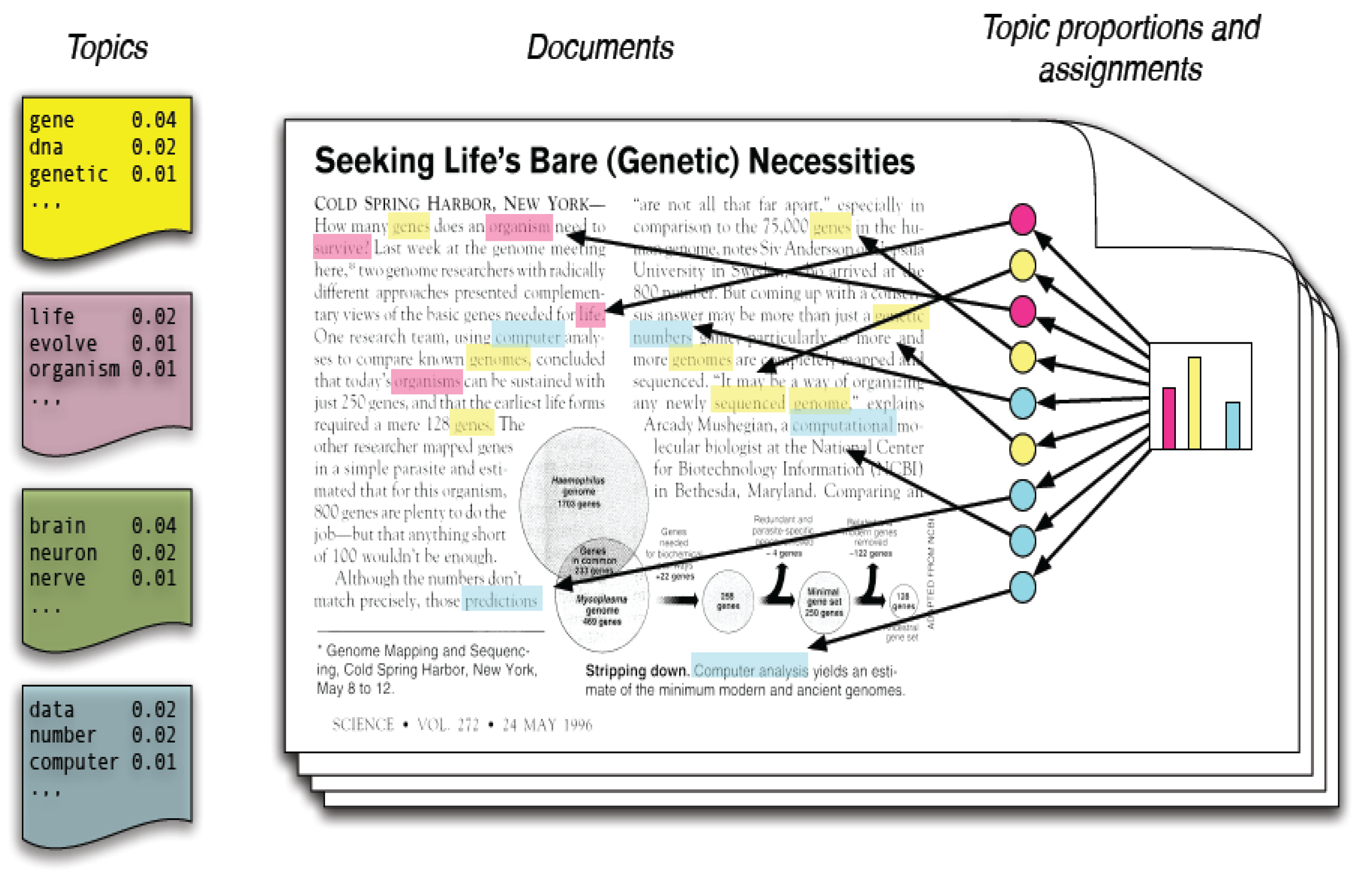

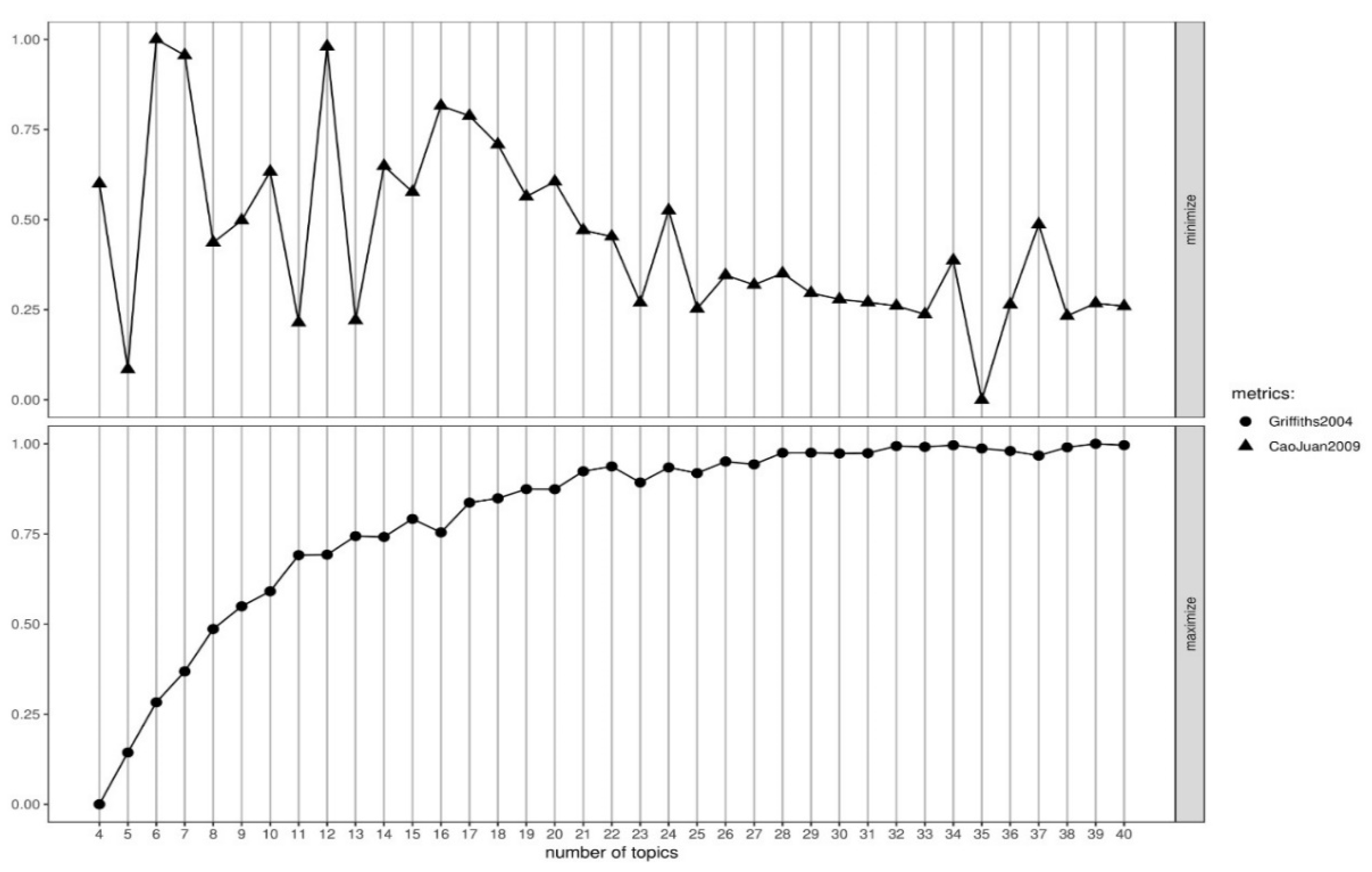


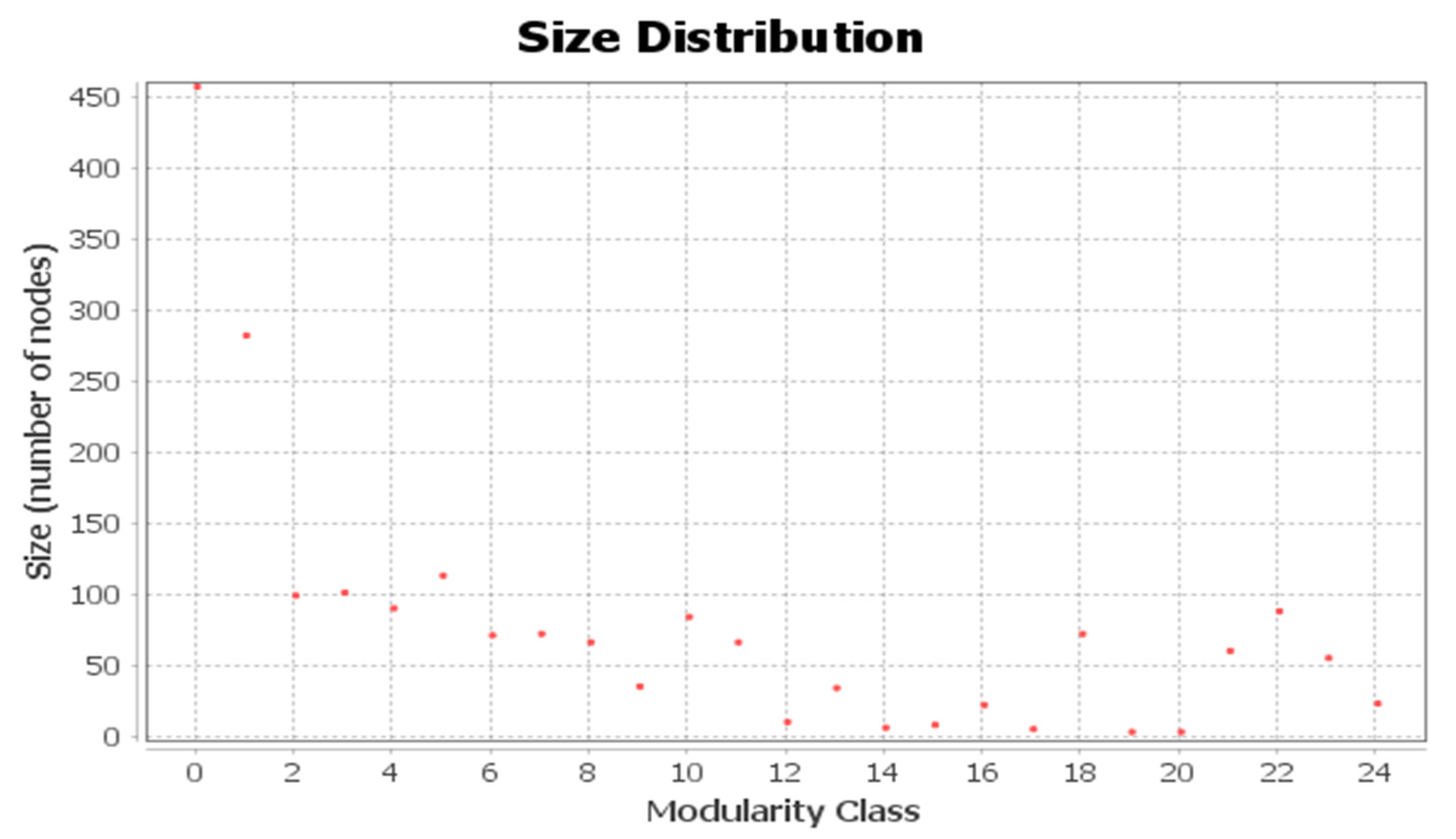
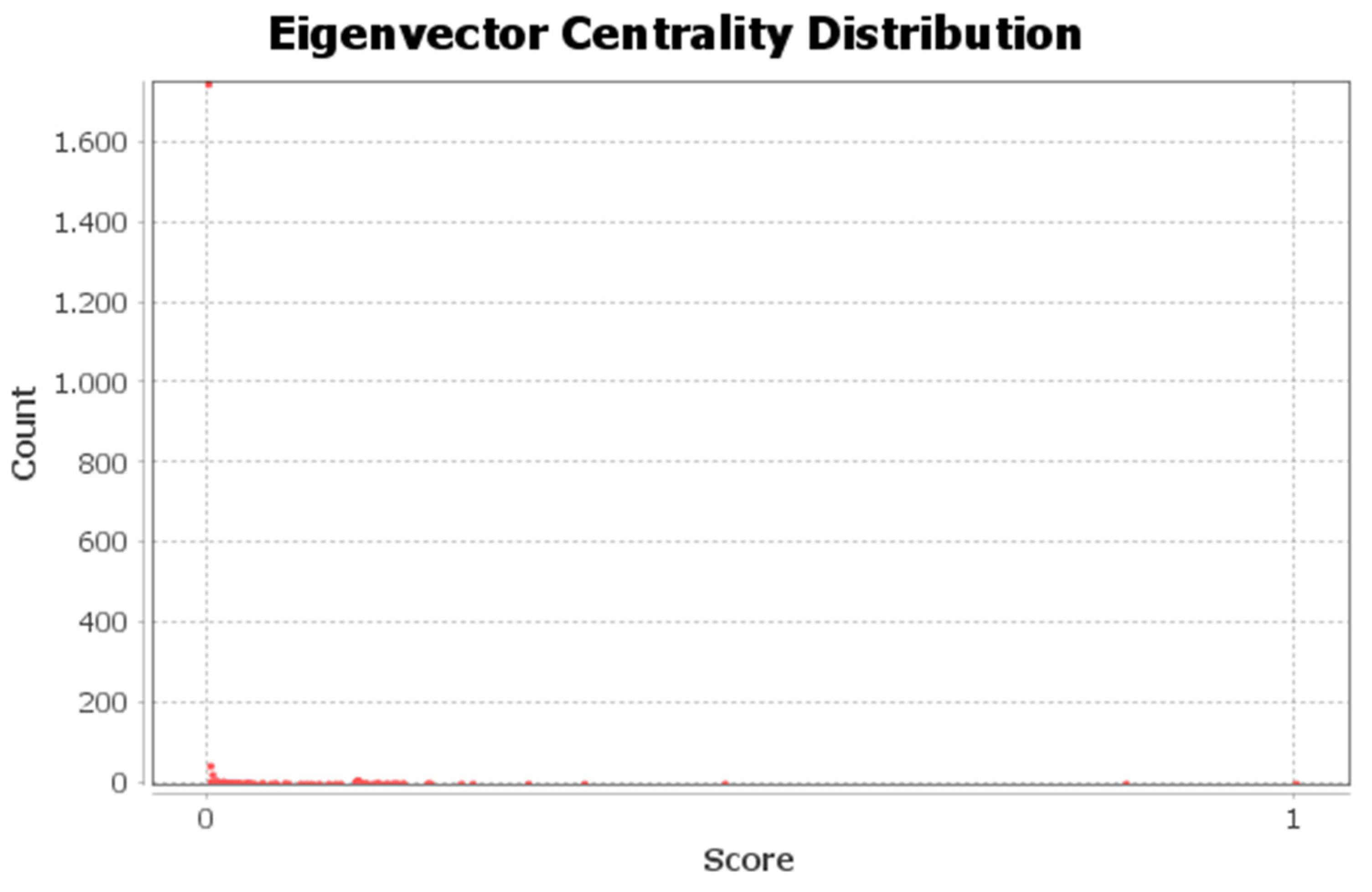
References
- Weng, L.; Menczer, F.; Ahn, Y.-Y. Virality prediction and community structure in social networks. Sci. Rep. 2013, 3, 2522. [Google Scholar] [CrossRef] [PubMed]
- Vosoughi, S.; Roy, D.; Aral, S. The spread of true and false news online. Science 2018, 359, 1146–1151. [Google Scholar] [CrossRef]
- Paul, M.J.; Dredze, M.; Broniatowski, D. Twitter Improves Influenza Forecasting. PLoS Curr. 2014, 6. [Google Scholar] [CrossRef] [PubMed]
- Smolinski, M.S.; Crawley, A.W.; Baltrusaitis, K.; Chunara, R.; Olsen, J.M.; Wójcik, O.; Santillana, M.; Nguyen, A.; Brownstein, J.S. Flu Near You: Crowdsourced Symptom Reporting Spanning 2 Influenza Seasons. Am. J. Public Health 2015, 105, 2124–2130. [Google Scholar] [CrossRef] [PubMed]
- Oliver, J.E.; Wood, T. Medical Conspiracy Theories and Health Behaviors in the United States. JAMA Intern. Med. 2014, 174, 817–818. [Google Scholar] [CrossRef]
- Miah, S.J.; Hasan, N.; Hasan, R.; Gammack, J. Healthcare support for underserved communities using a mobile social media platform. Inf. Syst. 2017, 66, 1–12. [Google Scholar] [CrossRef]
- Thomas, M.; Narayan, P. The Role of Participatory Communication in Tracking Unreported Reproductive Tract Issues in Marginalized Communities. Inf. Technol. Dev. 2016, 22, 117–133. [Google Scholar] [CrossRef]
- Young, S.D.; Rivers, C.; Lewis, B. Methods of using real-time social media technologies for detection and remote monitoring of HIV outcomes. Prev. Med. (Baltim) 2014, 63, 112–115. [Google Scholar] [CrossRef]
- Golder, V.; Morand, E.F.; Hoi, A.Y. Quality of Care for Systemic Lupus Erythematosus: Mind the Knowledge Gap. J. Rheumatol. 2017, 44, 271–278. [Google Scholar] [CrossRef] [PubMed]
- Stockl, A. Complex syndromes, ambivalent diagnosis, and existential uncertainty: The case of Systemic Lupus Erythematosus (SLE). Soc. Sci. Med. 2007, 65, 1549–1559. [Google Scholar] [CrossRef] [PubMed]
- Gergianaki, I.; Bertsias, G. Systemic Lupus Erythematosus in Primary Care: An Update and Practical Messages for the General Practitioner. Front. Med. 2018, 5, 161. [Google Scholar] [CrossRef] [PubMed]
- Reuter, K.; Danve, A.; Deodhar, A. Harnessing the power of social media: How can it help in axial spondyloarthritis research? Curr. Opin. Rheumatol. 2019, 31, 321–328. [Google Scholar] [CrossRef]
- Crowe, A.L.; McKnight, A.J.; McAneney, H. Communication Needs for Individuals with Rare Diseases Within and Around the Healthcare System of Northern Ireland. Front. Public Health 2019, 7, 236. [Google Scholar] [CrossRef] [PubMed]
- Tenderich, A.; Tenderich, B.; Barton, T.; Richards, S.E. What Are PWDs (People With Diabetes) Doing Online? A Netnographic Analysis. J. Diabetes Sci. Technol. 2019, 13, 187–197. [Google Scholar] [CrossRef] [PubMed]
- Rathore, A.K.; Kar, A.K.; Ilavarasan, P.V. Social Media Analytics: Literature Review and Directions for Future Research. Decis. Anal. 2017, 14, 229–249. [Google Scholar] [CrossRef]
- Mao, J.J.; Chung, A.; Benton, A.; Hill, S.; Ungar, L.; Leonard, C.E.; Hennessy, S.; Holmes, J.H. Online discussion of drug side effects and discontinuation among breast cancer survivors. Pharmacoepidemiol. Drug Saf. 2013, 22, 256–262. [Google Scholar] [CrossRef] [PubMed]
- Backa, K.E.; Holmberg, K.; Ek, S. Communicating diabetes and diets on Twitter—A semantic content analysis. Int. J. Netw. Virtual. Organ. 2016, 16, 8–24. [Google Scholar] [CrossRef]
- Xu, W.W.; Chiu, I.-H.; Chen, Y.; Mukherjee, T. Twitter hashtags for health: Applying network and content analyses to understand the health knowledge sharing in a Twitter-based community of practice. Qual. Quant. 2015, 49, 1361–1380. [Google Scholar] [CrossRef]
- Smith, K.T. Hospital Marketing and Communications Via Social Media. Serv. Mark. Q. 2017, 38, 187–201. [Google Scholar] [CrossRef]
- Smailhodzic, E.; Hooijsma, W.; Boonstra, A.; Langley, D.J. Social media use in healthcare: A systematic review of effects on patients and on their relationship with healthcare professionals. BMC Health Serv. Res. 2016, 16, 442. [Google Scholar] [CrossRef]
- Althubaiti, A. Information bias in health research: Definition, pitfalls, and adjustment methods. J. Multidiscip. Healthc. 2016, 9, 211–217. [Google Scholar] [CrossRef] [PubMed]
- Fan, W.; Gordon, M.D. The power of social media analytics. Commun. ACM 2014, 57, 74–81. [Google Scholar] [CrossRef]
- Kearney, M.W. Packagrtweet: Collecting Twitter Data. R Package Version 0.6.9e ‘Rtweet’ Title Collecting Twitter Data. 2019. Available online: https://cran.r-project.org/package=rtweet (accessed on 17 August 2019).
- Lou, C.; Yuan, S. Influencer Marketing: How Message Value and Credibility Affect Consumer Trust of Branded Content on Social Media. J. Interact. Advert. 2019, 19, 58–73. [Google Scholar] [CrossRef]
- Abidin, C. Communicative intimacies: Influencers and Perceived Interconnectedness. Ada J. Gender New Media Technol. 2015, 8, 1–16. [Google Scholar] [CrossRef]
- Kefi, H.; Indra, S.; Abdessalem, T. Social media marketing analytics: A multicultural approach applied to the beauty & cosmetics sector. In Proceedings of the Pacific Asia Conference on Information Systems PACIS, Chiayi, Taiwan, 27 June–1 July 2016; Available online: https://www.semanticscholar.org/paper/Social-media-marketing-analytics-%3A-a-multicultural-Kefi-Indra/98a22035e89e2d2573f1115d3e0b1dfc7ee82300 (accessed on 17 December 2019).
- Ananda, A.S.; Hernández-García, Á.; Lamberti, L. N-REL: A comprehensive framework of social media marketing strategic actions for marketing organizations. J. Innov. Knowl. 2016, 1, 170–180. [Google Scholar] [CrossRef]
- Jiménez-Castillo, D.; Sánchez-Fernández, R. The role of digital influencers in brand recommendation: Examining their impact on engagement, expected value and purchase intention. Int. J. Inf. Manag. 2019, 49, 366–376. [Google Scholar] [CrossRef]
- Arora, A.; Bansal, S.; Kandpal, C.; Aswani, R.; Dwivedi, Y. Measuring social media influencer index- insights from facebook, Twitter and Instagram. J. Retail. Consum. Serv. 2019, 49, 86–101. [Google Scholar] [CrossRef]
- Anger, I.; Kittl, C. Measuring influence on Twitter. In ACM International Conference Proceeding Series; ACM Press: New York, NY, USA, 2011; p. 1. [Google Scholar]
- Pavlopoulos, G.A.; Secrier, M.; Moschopoulos, C.N.; Soldatos, T.G.; Kossida, S.; Aerts, J.; Schneider, R.; Bagos, P.G. Using graph theory to analyze biological networks. BioData Min. 2011, 4, 10. [Google Scholar] [CrossRef]
- Blondel, V.D.; Guillaume, J.-L.; Lambiotte, R.; Lefebvre, E. Fast unfolding of communities in large networks. J. Stat. Mech. Theory Exp. 2008, P10008. [Google Scholar] [CrossRef]
- Jacomy, M.; Venturini, T.; Heymann, S.; Bastian, M. ForceAtlas2, a continuous graph layout algorithm for handy network visualization designed for the Gephi software. PLoS ONE 2014, 9, e98679. [Google Scholar] [CrossRef]
- Bonacich, P.; Lloyd, P. Eigenvector centrality and structural zeroes and ones: When is a neighbor not a neighbor? Soc. Netw. 2015, 43, 86–90. [Google Scholar] [CrossRef]
- Meera Gandhi, G. Identification of Potential Influencers in Facebook Using Network Graph Metrics. 2014. Available online: http://www.digitalxplore.org/up_proc/pdf/88-140479998117-21.pdf (accessed on 18 December 2019).
- Leonard, M.; Graham, S.; Bonacum, D. The human factor: The critical importance of effective teamwork and communication in providing safe care. Qual. Saf. Health Care 2004, 13, 361–362. [Google Scholar] [CrossRef]
- Blei, D.M. Probabilistic topic models. Commun. ACM 2012, 55, 77–84. [Google Scholar] [CrossRef]
- Blei, D.M.; Ng, A.Y.; Jordan, M.I. Latent Dirichlet allocation. J. Mach. Learn. Res. 2003, 3, 993–1022. [Google Scholar]
- Roberts, M.E.; Stewart, B.M.; Tingley, D.; Lucas, C.; Leder-Luis, J.; Gadarian, S.K.; Albertson, B.; Rand, D.G. Structural topic models for open-ended survey responses. Am. J. Pol. Sci. 2014, 58, 1064–1082. [Google Scholar] [CrossRef]
- Roberts, M.E.; Stewart, B.M.; Tingley, D. Stm: An R package for structural topic models. J. Stat. Softw. 2019, 91. [Google Scholar] [CrossRef]
- Griffiths, T.L.; Steyvers, M. Finding scientific topics. Proc. Natl. Acad. Sci. USA 2004, 101, 5228–5235. [Google Scholar] [CrossRef] [PubMed]
- Cao, J.; Xia, T.; Li, J.; Zhang, Y.; Tang, S. A density-based method for adaptive LDA model selection. Neurocomputing 2009, 72, 1775–1781. [Google Scholar] [CrossRef]
- Murzintcev, N. Package ‘Ldatuning’ Title Tuning of the Latent Dirichlet Allocation Models Parameters Description Estimates the Best Fitting Number of Topics. 2019. Available online: https://cran.r-project.org/web/packages/ldatuning/ldatuning.pdf (accessed on 21 December 2019).
- Mimno, D.; Wallach, H.M.; Talley, E.; Leenders, M.; McCallum, A. Optimizing semantic coherence in topic models. In Proceedings of the EMNLP 2011—Conference on Empirical Methods in Natural Language Processing, Edinburgh, Scotland, UK, 27–31 July 2011; Association for Computational Linguistics: Stroudsburg, PA, USA, 2011; pp. 262–272. [Google Scholar]
- Airoldi, E.M.; Bischof, J.M. Improving and Evaluating Topic Models and Other Models of Text. J. Am. Stat. Assoc. 2016, 111, 1381–1403. [Google Scholar] [CrossRef]
- Wheeler, L.M.; Pakozdi, A.; Rajakariar, R.; Lewis, M.; Cove-Smith, A.; Pyne, D. 139 Moving with the Times: Social Media Use Amongst Lupus Patients. Rheumatology 2018, 57, key075-363. [Google Scholar] [CrossRef]
- Jiang, S. Functional interactivity in social media: An examination of Chinese health care organizations’ microblog profiles. Health Promot. Int. 2019, 34, 38–46. [Google Scholar] [CrossRef]
- Wang, Y.; McKee, M.; Torbica, A.; Stuckler, D. Systematic Literature Review on the Spread of Health-related Misinformation on Social Media. Soc. Sci. Med. 2019, 240, 112552. [Google Scholar] [CrossRef] [PubMed]
- Haas-Wilson, D. Arrow and the Information Market Failure in Health Care: The Changing Content and Sources of Health Care Information. J. Health Polit. Policy Law 2001, 26, 1031–1044. [Google Scholar] [CrossRef]
- Fletcher-Brown, J.; Pereira, V.; Nyadzayo, M.W. Health marketing in an emerging market: The critical role of signaling theory in breast cancer awareness. J. Bus. Res. 2018, 86, 416–434. [Google Scholar] [CrossRef]
- Nikolenko, S.I.; Koltcov, S.; Koltsova, O. Topic modelling for qualitative studies. J. Inf. Sci. 2017, 43, 88–102. [Google Scholar] [CrossRef]
- Al Moubayed, N.; McGough, S.; Awwad Shiekh Hasan, B. Beyond the topics: How deep learning can improve the discriminability of probabilistic topic modelling. PeerJ Comput. Sci. 2020, 6, e252. [Google Scholar] [CrossRef]
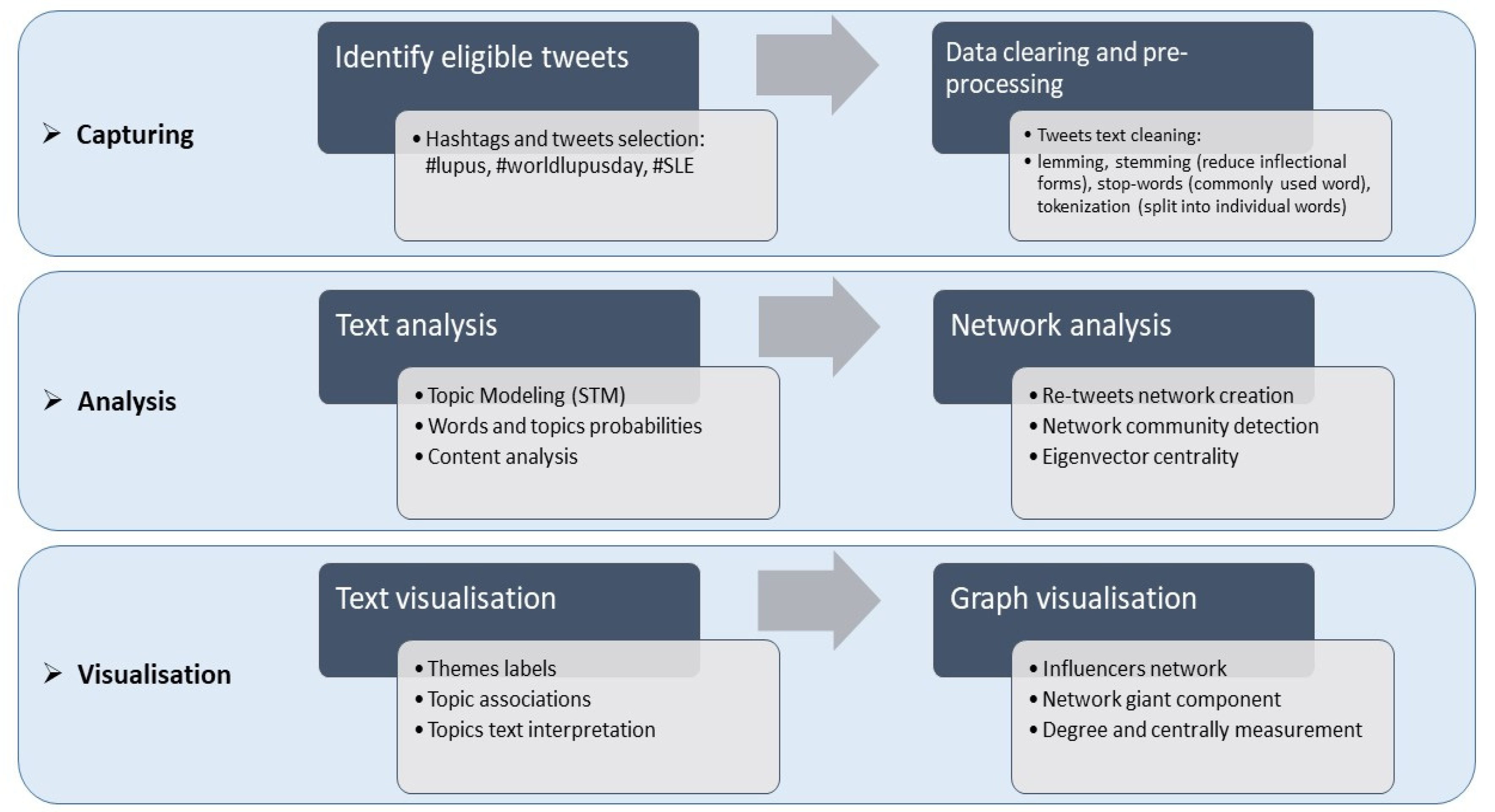

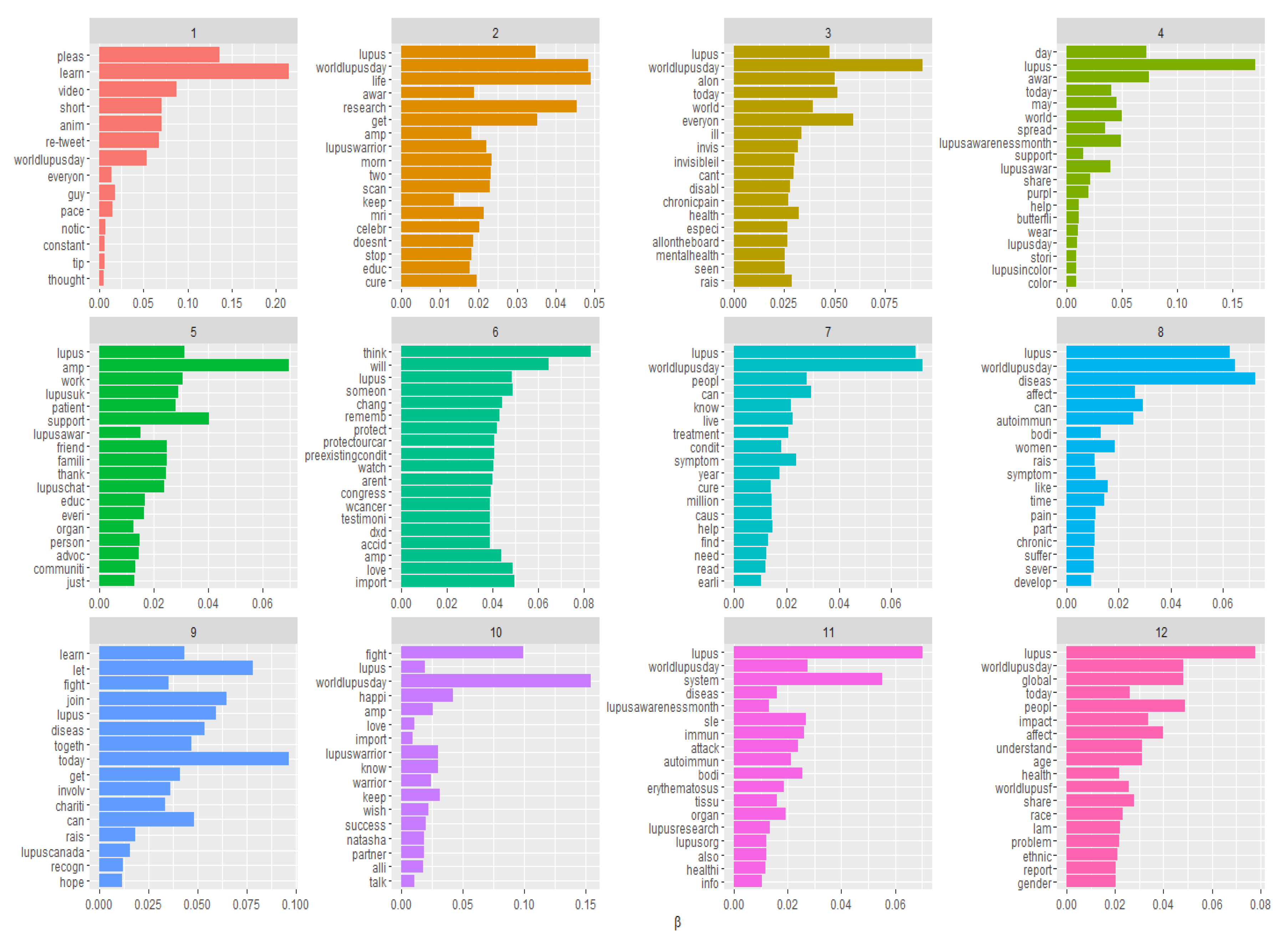
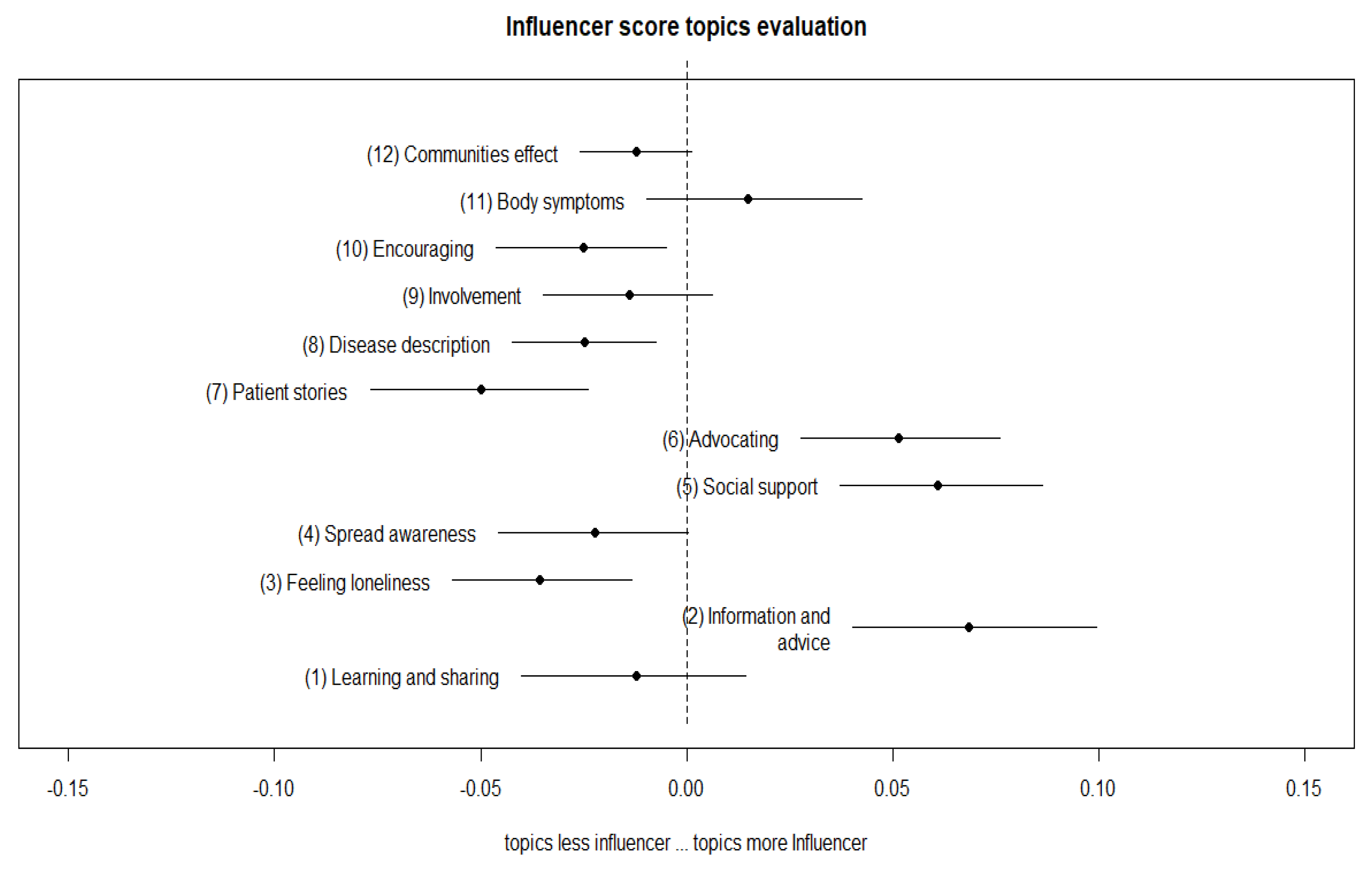

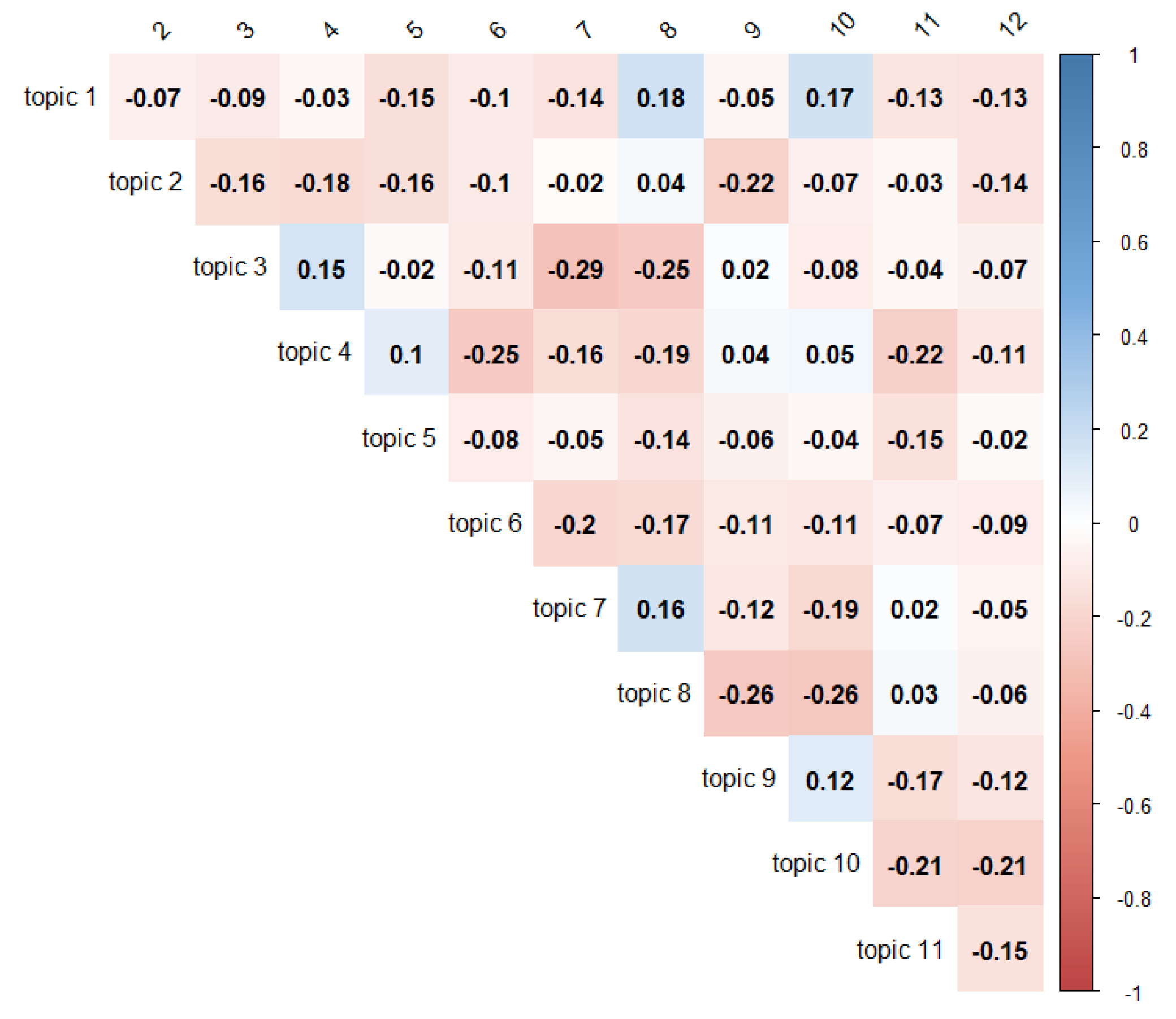
| Title | Screen Name | Influencer Score | Screen Name | Network Influencer Score |
|---|---|---|---|---|
| 1 | Integrated clinical Hospital; USA | 35.182 | Peter Morley | 0.99 |
| 2 | information boards Blog; UK | 26.257 | lupusuk | 0.66 |
| 3 | Physiopedia | 21.259 | Information boards Blog; UK | 0.37 |
| 4 | Newspaper; South Africa | 20.830 | Advocate page; USA | 0.28 |
| 5 | Radio; Nigeria | 12.814 | Lupus charity; USA | 0.24 |
| 6 | HibbsLupusTrust | 12.271 | Charity; UK | 0.18 |
| Learning and sharing (topic 1): “To anyone with Lupus, it does get better. With time you learn your triggers, you learn to pace yourself and most importantly you learn to listen to your own body.”; “Help us spread awareness for #lupus on #WorldLupusDay!” “Learn more about #lupus brain fog and get tips for coping with it in our article at.” |
| Information and advice (topic 2): “Do eat a healthy, balanced diet try to stay active when you’re having a flare-up try walking or swimming get lots of rest try relaxation techniques to manage stress”; “stress can make symptoms worse.” “For information about available support, please take a look at our article here.” |
| Feeling loneliness (topic 3): “Invisible. For everyone with a disability or an illness that can’t be seen. YOU are not alone, WE are not alone. Today is #WorldLupusDay and we are especially thinking of everyone in the world who has #Lupus #invisibleillness #chronicpain #health #mentalhealth.” “In conjunction of special day for this invisible illness I would like to encourage everybody to appreciate your health and for all Lupus fighter in the world.” |
| Spread awareness (topic 4): “MAY 10 is WORLD LUPUS DAY! Spread Lupus Awareness share the Lupus In Color Butterfly Woman. Spread Lupus Awareness Today!”; “Today is World Lupus Day! Show me your purple! #LupusAwarenessMonth,”; “I chose purple, and you?” |
| Social support (topic 5): “Today around the world #Lupus advocates, patients, and amp; supporters are working hard to spread #LupusAwareness. For #WorldLupusDay we’ll highlight our #LupusChat community members, advocates, caregivers, doctors, and friends who work tirelessly daily to educate others about Lupus.” “Just because something doesn’t directly affect you doesn’t make it irrelevant. Sending out strength and encouragement to everyone battling lupus, extra love to my queen.” |
| Advocating (topic 6): “Government would prefer narcotics or sleep medication, which isn’t natural and addictive but that’s ok they get their money from the big old pharma companies #kickbacks #opioidcrisis but they’re getting paid right?!?”; “#WorldLupusDay; Sen Resolution presented (…) We encourage ALL our legislators to join them.”; “If you think #PreExistingConditions protections aren’t important, remember someone you love could have an accident, that will change how you think about this.” |
| Patient stories (topic 7): “My scars are my war wounds, my proof that I survived. They show me that I am...” “Lupus is a long-term condition causing inflammation to the joints, skin and other organs. There’s no cure, but symptoms can improve if treatment starts early. Read about the symptoms here…” |
| Disease description(topic 8): “#Lupus is a severe + life-changing autoimmune disease that can affect any organ in the body. Yet it is also an illness where “but you don’t look sick” is truly apt as the pain, suffering + heavy duty meds aren’t always visible.”; “Symptoms can flare up and settle down, often the disease flares up (relapses) and symptoms become worse for a few weeks, sometimes longer.” “How lupus is diagnosed? As lupus symptoms can be similar to lots of other conditions, it can take some time to diagnose.” |
| Involvement (topic 9): “Learn more about the disease and how you can get involved with the charity at”; “Let’s Join Together to Fight Lupus! #WorldLupusDay”; “Did you know that over 1:1000 Canadian men, women and children are living with lupus? Let’s join together in the fight against #lupus!” |
| Encouraging (topic 10): “Keep fighting and know we are fighting with YOU!”; “to all the Lupus Warriors still fighting every day. You’re amazing and you’re strong. Keep the faith.”; “To all those living with Lupus around the world, keep fighting and may your efforts to awareness be successful.” |
| Body symptoms(topic 11): “As well as the 3 main symptoms, you might also have: weight loss, swollen glands, sensitivity to light (causing rashes on uncovered skin), poor circulation in fingers and toes (Raynaud’s)”; “#Lupus is a long-term autoimmune disease in which the body’s immune system becomes hyperactive and attacks normal, healthy tissue.”; “The immune system protects the body against infections and diseases. However, in Lupus, the immune system starts attacking the body’s healthy tissue, leading to organ damage and chronic inflammation.” |
| Communities effect (topic 12): “lupus affects approx. 5 million people globally yet there is still a lack of awareness amongst general public and healthcare professionals? On #WorldLupusDay join us in encouraging greater understanding of this condition.”; “Today is #WorldLupusDay. Lupus is a global health problem that affects people of all nationalities, races, ethnicities, genders and ages! There are about 200,000 cases diagnosed in Kenya.”; “Lupus is a global health problem that affects people of all nationalities, races, ethnicities, genders and ages.” |
© 2020 by the authors. Licensee MDPI, Basel, Switzerland. This article is an open access article distributed under the terms and conditions of the Creative Commons Attribution (CC BY) license (http://creativecommons.org/licenses/by/4.0/).
Share and Cite
Pirri, S.; Lorenzoni, V.; Andreozzi, G.; Mosca, M.; Turchetti, G. Topic Modeling and User Network Analysis on Twitter during World Lupus Awareness Day. Int. J. Environ. Res. Public Health 2020, 17, 5440. https://doi.org/10.3390/ijerph17155440
Pirri S, Lorenzoni V, Andreozzi G, Mosca M, Turchetti G. Topic Modeling and User Network Analysis on Twitter during World Lupus Awareness Day. International Journal of Environmental Research and Public Health. 2020; 17(15):5440. https://doi.org/10.3390/ijerph17155440
Chicago/Turabian StylePirri, Salvatore, Valentina Lorenzoni, Gianni Andreozzi, Marta Mosca, and Giuseppe Turchetti. 2020. "Topic Modeling and User Network Analysis on Twitter during World Lupus Awareness Day" International Journal of Environmental Research and Public Health 17, no. 15: 5440. https://doi.org/10.3390/ijerph17155440
APA StylePirri, S., Lorenzoni, V., Andreozzi, G., Mosca, M., & Turchetti, G. (2020). Topic Modeling and User Network Analysis on Twitter during World Lupus Awareness Day. International Journal of Environmental Research and Public Health, 17(15), 5440. https://doi.org/10.3390/ijerph17155440







